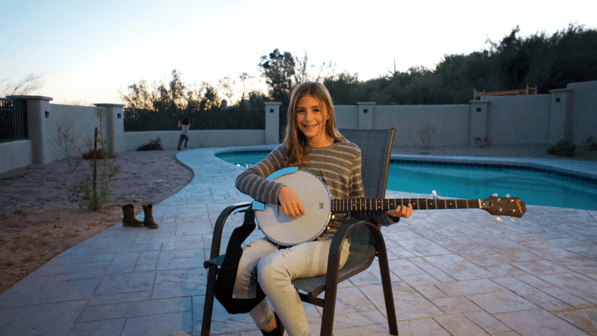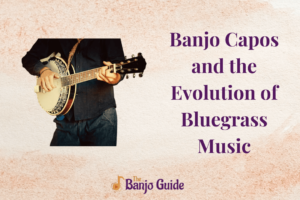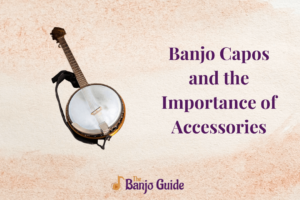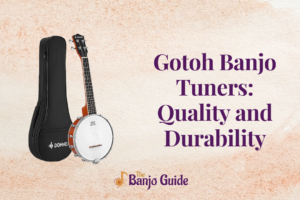Banjo capos are made for banjos. They are designed similarly to other stringed instrument capos. But what’s the difference between the two? If you have been wondering about this for a long time, you are in the right place.

This article will teach you about banjo capos vs. other stringed instrument capos. The article will discuss their advantages and disadvantages, different capo styles, unique banjo capo features, the pros and cons of using a standard capo on your banjo, and alternatives.
How Banjo Capos Differ From Guitar And Mandolin Capos?
Banjo capos differ from guitar and mandolin capos in many ways:
- Length Of The Neck: Banjo capos are shorter in length than guitar and mandolin capos. Why? Because the neck of the banjo is short. The short length of the banjo capos helps it fit the banjo seamlessly.
- Pressure Distribution: Banjo capos distribute the pressure equally on banjo strings. They have a slightly curved shape. This prevents any unnecessary buzzing or intonation issues. Guitar and mandolin capos also need to distribute equal pressure. Their shape varies depending on the fingerboard radius and neck profile.
- Neck Configuration: The neck profile of a banjo differs from that of a guitar or mandolin. So, banjo capos are specifically designed to fit the banjo neck, unlike guitar and mandolin capos.
Advantages And Disadvantages Of Using A Banjo Capo
Using a banjo capo offers many advantages along with a few potential disadvantages. Keep reading to learn more about banjo capo benefits and drawbacks.
- Advantages:
- A banjo capo allows a musician to change the song’s key easily. A banjo player won’t have to change his finger positions to change the key. The player can place the capo on a specific fret to raise the pitch. In this case, the player does not have to learn chord shapes or patterns.
- Switching between different keys will be easy with a banjo capo. Musicians can use the banjo capo to change between different keys easily. This is why knowing about adjustable vs fixed banjo capos is essential.
- Banjo players can move the banjo capo to different frets. This will help them experiment. This allows players to learn unique tonalities. It opens up a world of new possibilities inaccessible otherwise.
- Disadvantages:
- Banjo capos often alter the tone of a banjo. It applies pressure on the strings. This can have a huge impact on the performance. It changes the natural resonance of the banjo.
- Improper placement of a banjo capo can strike intonation problems. It can cause a string buzz. This is why it is important to place it right.
Banjo Capo Styles And Their Unique Features
There are many banjo capo styles available. Each style has its unique features. Let’s learn about some common banjo capo styles below:
- Trigger Style Capo: Trigger-style banjo capos use a trigger mechanism. This capo can easily be placed on the banjo neck. This capo is popular amongst banjo players globally. It allows banjo players to make quick adjustments conveniently. It is also known as quick-release capo.
- Partial Capo: A partial capo is useful for unique tuning. Partial capo for banjo covers banjo strings partially. Many different partial capo configurations are available in the market. Some configurations will cover individual strings. Some configurations will cover specific frets. It enhances creativity potential.
- Toggle Style Capo: Toggle style capos have a toggle. This toggle flips to secure the capo on the neck. The inner side of the capo has a silicone pad for grip. It offers a fast and convenient application. This capo can be removed very swiftly.
- Spring Loaded Capo: Spring-loaded capo uses a spring-loaded mechanism. It can be used single-handedly. The tension of the spring holds the capo in place. These capos are made with rubber for better grip.
Using A Standard Capo On Banjo: Pros And Cons
A standard capo is usually designed for guitars, mandolins, and other stringed instruments. Using a standard guitar capo on tenor banjo has its own pros and cons. Let’s learn more about them below:
- Pros:
- Standard capos offer versatility. The same capo can be used for multiple instruments. It is the best choice for musicians who play several instruments.
- Standard capos are easily available in all online and offline music stores. It is the go-to option for all musicians.
- Standard capos fulfill the basic transposition function well. It can be placed on a specific fret to raise the pitch. The player will not have to change finger positions to achieve a high pitch.
- Cons:
- Standard capos might not always serve useful for banjos. Sometimes, a banjo’s unique neck and bridge configuration can make a standard capo an improper fit. This can create intonation issues.
Banjo Capo Alternatives: What Are Your Options?
Are you searching for the best banjo capo alternatives? Then below are a few options you might want to consider:
- Fifth-String Capo: A fifth-string capo is specifically designed for the 5th string of the banjo. This leaves the other strings open. The fifth-string capo is a small device. It helps musicians achieve alternate tunings.
- Elastic Band: An elastic band can be used as a capo. The elastic band can be wrapped around the neck. The elastic band is positioned to achieve the desired pitch. It has a capo-like effect. It is only a temporary alternative.
- Railroad Spike: A railroad spike needs to be installed on the banjo fingerboard. This small device serves as a fixed capo. It is used to raise the pitch of a banjo. Bluegrass banjo players use railroad spikes the most. It allows them to make quick key changes conveniently. Using a capo for bluegrass banjo? Try railroad spikes.
Summary
Although banjo capos are designed for banjos, capos designed for other stringed instruments can be used with a banjo. It is always a good idea to check the compatibility of a banjo capo beforehand.
There can be a few similarities between banjo capos and capos for other stringed instruments. However, it is best to use a capo designed for a specific musical instrument.
Ultimately, the decision to use a banjo capo or not depends on personal preference. Taking the pros and cons of a banjo capo into consideration can help you make the best decision.
There are many banjo capo styles and designs available in the market. Each style has its own advantages and disadvantages. Choose a style that best matches your playability and pocket.
While a standard banjo capo can work wonders for some banjos, it is best to keep their limitations in mind. Invest in a banjo-specific capo for the best results.
There are many kinds of banjo capo alternatives out there. Choose the alternative that best suits your specific needs.
FAQs
-
Are some capos better than others?
Yes, some capos are better than others. Investing in a good-quality capo is always the best decision. They are more durable. They hold the strings tightly for better performance.
-
Does capo affect tuning?
Yes, using a capo can affect the tuning of an instrument like banjo. Some cheap-quality capos can put excess pressure on the strings. This might pull them out of tune.
-
Should a beginner purchase a capo?
Yes, a beginner guitarist or banjo player can benefit from purchasing a capo. One of the best benefits of purchasing a capo is that it allows the musician to play more songs with less chords.



